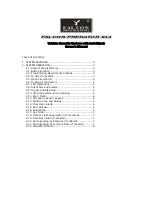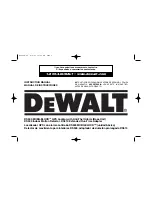
1
User Manual: LAN_UM_SMK-1 Rev A
INTRODUCTION
Lansen
’s
photoelectric smoke detector LAN-WMBUS-SMK-1
series is designed to sense smoke that comes into the alarm
chamber. It does not sense gas, or flame. This smoke alarm is
designed to give early warning of developing fires by givin g off
the alarm sounds from its built-in alarm horn. It can provide
precious time for you and your family to escape before a fire
spreads. However, the smoke alarm makes such pre-warning of
fire accident possible, only if the smoke alarm is located,
installed, and maintained properly as described in this User's
Manual.
WARNING:
This smoke alarm is designed for use in single residential
unit only, which means it should be used inside a single family home or
apartment. In mutli-family residential buildings or apartment, each family
living unit should install its own smoke alarms.
WARNING:
This alarm is not meant to be used in non-residential
buildings. Warehouses, industrial or commercial buildings, and special
purpose non-residential buildings require special fire detection and alarm
systems. This smoke alarm alone is not a suitable substitute for complete
fire detection systems for places where many people live or work, such as
hotels or motels. The same is true of dormitories, hospitals, nursing
homes or group homes of any kind, even if they were once single family
homes. Please refer NFPA 101, the Life Safety Code, NFPA 72A for
smoke alarm requirements for fire protection in buildings not defined as
“households”.
WARNING:
This smoke alarm will not alert people who are hard of
hearing. It is strongly recommended that the special-purpose smoke
alarms, using lights or vibrating devices, should be installed to alert
occupants who are hard of hearing.
LOCATIONS TO INSTALL YOUR SMOKE ALARM
Smoke alarms should be installed in accordance with the NFPA Standard
72 (National Fire Protection Association, Battery march Park, Quincy, MA
02169). For complete coverage in residential units, smoke alarms should
be installed in all rooms, halls, storage areas, basements, and attics in
each family living unit. Minimum coverage is one alarm on each floor and
one in each sleeping area.
Here, we have useful tips for you:
˙
Install a smoke alarm in each separate room and exit way except
kitchen, as shown in Figure 1 and Figure 2.
˙
Install a smoke alarm on every floor of a multi-floor home or apartment,
as shown in Figure 3.
˙
Install a minimum of two alarms in any household.
˙
Install a smoke alarm inside every bedroom.
˙
Install smoke alarms at both ends of a bedroom hallway if the hallway is
more than 40 feet (12 meters) long.
˙
Install basement alarms at the bottom of the basement stairwell.
˙
Install second-floor alarms at the top of the first-to-second floor
stairwell.
Be sure no door or other obstruction blocks the path of smoke to the
alarm
˙
Install additional alarms in your living room, dining room, family room,
attic, utility and storage rooms.
˙
Install smoke alarms as close to the center of the ceiling as possible. If
this is not practical, put the alarm on the ceiling, no closer than 20
inches (50 cm) from any wall or corner, as shown in Figure 4.
˙
If ceiling mounting is not possible and wall mounting is permitted by
your local and state codes, put wall-mounted alarms between 4 and 6
inches (10 ~ 15 cm) from the ceiling, also see Figure 4.
˙
If some of your rooms have sloped, peaked, or gabled ceilings, try to
mount alarms 3 feet (0.9 meter) measured horizontally from the highest
point of the ceiling as shown in Figure 5.
Figure 4:
IF IT IS NOT PRACTICAL TO MOUNT
THE ALARM ON THE CENTER OF
CEILING , PUT THE ALARM ON THE
CEILING, NO CLOSER THAN 50 cm TO
ANY WALL OR CORNER , AS SHOWN
IN FIGURE 4
Figure 5:
THE DISTANCE BETWEEN THE PEAK
AND THE MOUNTING POINT OF THE
SMOKE ALARM ON PEAKED
CEILINGS(>20°) IS MINIMUM 0.5M TO
MAXIMUM 1 M MEASURED ALONG
THE PEAKED CEILING
CAUTION
(As required by the California State Fire Marshall)
“Early warning fire ”
detection is best achieved by the installation of fire
detection equipment in all rooms and areas of the household as follows: (1)
A smoke alarm installed in each separate sleeping area (in the vicinity, but
outside of the bedrooms), and (2) Heat or smoke alarms in the living
rooms, dining rooms, bedrooms, kitchens, hallways, attics, furnace rooms,
closets, utility and, storage rooms, basements and attached garages.”
For your information, NFPA Standard 72, Section 29 reads as follows:
“
29.5.1 Smoke alarms shall be installed outside of each separate sleeping
area in the immediate vicinity of the bedrooms and on each additional
story of the family living unit including basements and excluding crawl
spaces and unfinished attics.
The provisions of 29.5.1 represent the minimum number of alarms
required by this standard. It is recommended that the householder
consider the use of additional smoke alarms for increased protection for
those areas separated by a door from the areas protected by the required
smoke alarms under 29.5.1 above. The recommended additional areas
are living room, dining room, bedroom(s), kitchen, attic (finished or
unfinished), furnace rooms, utility room, basement, integral or attached
garage, and hallways not included in 29.5.1 above. However, the use of
additional alarms remains the option of the househ
older.” We recommend
complete coverage and use of additional smoke alarms.
LOCATIONS NOT TO INSTALL YOUR SMOKE ALARMS
Nuisance alarms take place when smoke alarms are installed where they
will not work properly. To avoid nuisance alarms, do not install smoke
alarms in the following situations:
˙
Combustion particles are the by-products of something that is burning.
Thus, in or near areas where combustion particles are present you do
not install the smoke alarms to avoid nuisance alarms, such as kitchens
with few windows or poor ventilation, garages where there may be
vehicle exhaust, near furnaces, hot water heaters, and space heaters.
˙
Do not install smoke alarms less than 20 feet (6 meters) away from
places where combustion particles are normally present, like kitchens. If
a 20-foot distance is not possible, e.g. in a mobile home, try to install
the alarm as far away from the combustion particles as possible,
preferably on the wall. To prevent nuisance alarm alarms, provide good
ventilation in such places.
IMPORTANT
:
For any reason, do not disable the unit to avoid
nuisance alarms.
˙
When air streams passing by kitchens, the way how an smoke alarm
can sense combustion particles in normal air-flow paths is graphically
shown in Figure 6, which indicates the correct and incorrect smoke
alarm locations concerning this problem.
Figure 1:
ONE SEPARATE SMOKE ALARM IN
EVERY BEDROOM AND ONE SMOKE
ALARM IN THE FLOOR FOR MORE
SECURITY.
Figure 2:
ONE SEPARATE SMOKE ALARM IN
EVERY ROOM, EXCEPT KITCHEN
AND BATHROOM AS A MINIMUM
SECURITY
LONG BATTERY LIFE SINGLE STATION
BATTERY POWERED
PHOTOELETRIC SMOKE ALARM
LAN-WMBUS-SMK-1
USER’S MANUAL
Figure 3:
LOCATION FOR PLACING
SMOKE ALARMS FOR A
MULTI-FLOOR RESIDENCE
Smoke alarms for minimum security
Quick installation guide SMK





















